Thoroughly analyzing TS Inter 1st Year Maths 1A Model Papers and TS Inter 1st Year Maths 1A Question Paper May 2017 helps students identify their strengths and weaknesses.
TS Inter 1st Year Maths 1A Question Paper May 2017
Time: 3 Hours
Maximum Marks: 75
Note: This question paper consists of three sections A, B, and C.
Section – A
(10 × 2 = 20 Marks)
I. Very Short Answer Type Questions.
- Answer all questions.
- Each question carries two marks.
Question 1.
If A = \(\left\{0, \frac{\pi}{6}, \frac{\pi}{4}, \frac{\pi}{3}, \frac{\pi}{2}\right\}\) and f: A → B is a surjection defined by f(x) = cos x, then find B.
Solution:
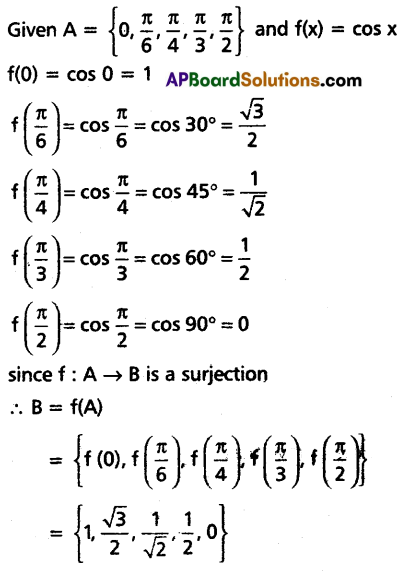
Question 2.
If f: R → R, g: R → R are defined by f(x) = 3x – 1, g(x) = x2 + 1, then find:
(i) fog (2)
(ii) gof (2a – 3)
Solution:
(i) (fog) (2) = f[g(2)]
= f[22 + 1]
= f(5)
= 3(5) – 1
= 15 – 1
= 14
∴ (fog) (2) = 14
(ii) (gof) (2a – 3) = g[f(2a – 3)]
= g[3(2a – 3) – 1]
= g[6a – 9 – 1]
= g(6a – 10)
= (6a – 10)2 + 1
= 36a2 – 120a + 100 + 1
= 36a2 – 120a + 101
∴ (gof) (2a – 3) = 36a2 – 120a + 101
![]()
Question 3.
Define the Skew-symmetric matrix and give one example of it.
Solution:
Skew-Symmetric matrix: A square matrix is said to be a skew-symmetric matrix if AT = -A.
Ex: A = \(\left[\begin{array}{rrr}
0 & a & b \\
-a & 0 & c \\
-b & -c & 0
\end{array}\right]\)
Question 4.
If A = \(\left[\begin{array}{lll}
3 & 0 & 0 \\
0 & 3 & 0 \\
0 & 0 & 3
\end{array}\right]\), then find A4.
Solution:
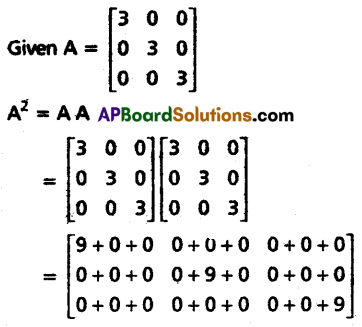
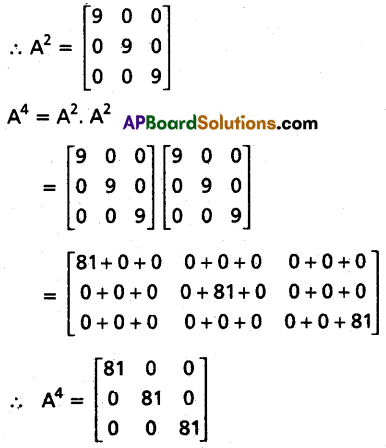
Question 5.
Show that the points whose position vectors are \(-2 \bar{a}+3 \bar{b}+5 \bar{c}\), \(\bar{a}+2 \bar{b}+3 \bar{c}, 7 \bar{a}-\bar{c}\) are collinear when \(\bar{a}, \bar{b}, \bar{c}\) are non-coplanar vectors.
Solution:
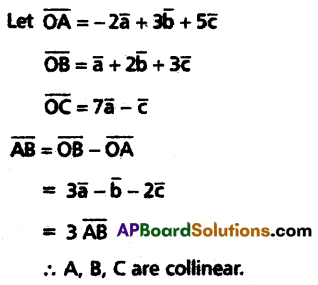
Question 6.
Find the unit vector in the direction of the vector \(\bar{a}=2 \bar{i}+3 \bar{j}+\bar{k}\).
Solution:

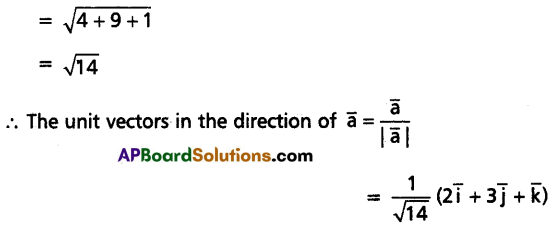
Question 7.
Find the area of the parallelogram whose diagonals are \(3 \bar{i}+\bar{j}-2 \bar{k}\) and \(\overline{\mathrm{i}}-3 \overline{\mathrm{j}}+4 \overline{\mathrm{k}}\).
Solution:
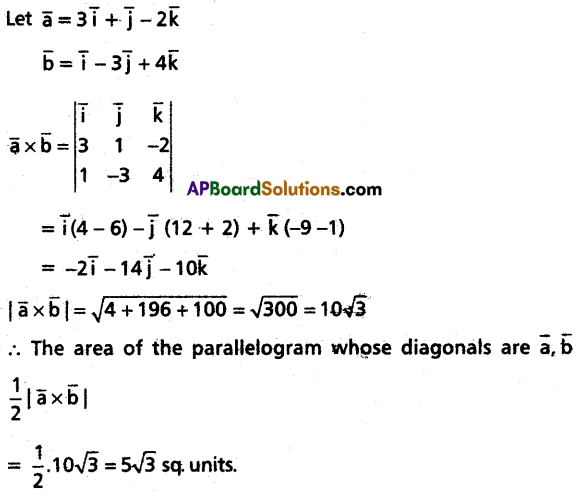
Question 8.
Find the period of the function f(x) = cos (3x + 5) + 7.
Solution:
Given f(x) = cos (3x + 5) + 7
∴ The period of f(x) = \(\frac{2 \pi}{3}\)
![]()
Question 9.
If sin α = \(\frac{1}{\sqrt{10}}\), sin β = \(\frac{1}{\sqrt{5}}\) and α, β are acute, then show that α + β = \(\frac{\pi}{4}\).
Solution:
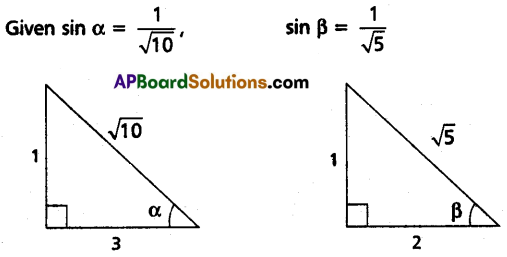
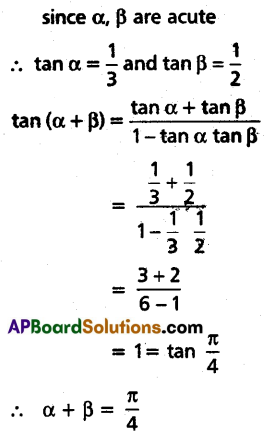
Question 10.
If cosh x = \(\frac{5}{2}\), then find the values of cosh (2x), sinh (2x).
Solution:
Given cos hx = \(\frac{5}{2}\)
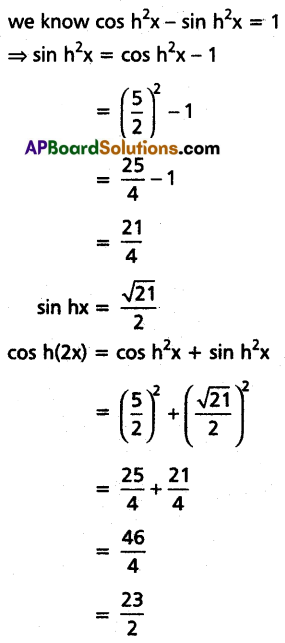
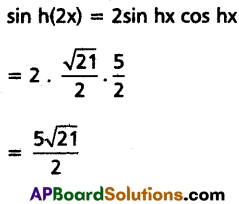
Section – B
(5 × 4 = 20 Marks)
II. Short Answer Type Questions.
- Attempt any five questions.
- Each question carries four marks.
Question 11.
If θ – φ = \(\frac{\pi}{2}\), then show that \(\left[\begin{array}{cc}
\cos ^2 \theta & \cos \theta \sin \theta \\
\cos \theta \sin \theta & \sin ^2 \theta
\end{array}\right]\left[\begin{array}{cc}
\cos ^2 \phi & \cos \phi \sin \phi \\
\cos \phi \sin \phi & \sin ^2 \phi
\end{array}\right]\) = 0
Solution:


Question 12.
Let ABCDEF be a regular hexagon with a center ‘O’. Show that \(\overline{\mathrm{AB}}+\overline{\mathrm{AC}}+\overline{\mathrm{AD}}+\overline{\mathrm{AE}}+\overline{\mathrm{AF}}=3 \overline{\mathrm{AD}}=6 \overline{\mathrm{AO}}\).
Solution:
Given that ABCDEF is a regular hexagon.

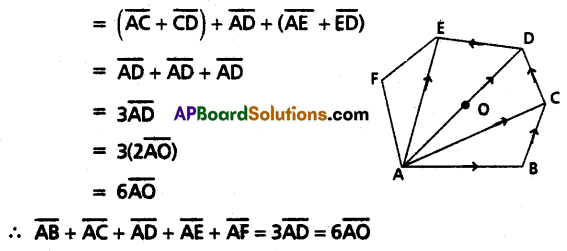
Question 13.
If \(\bar{a}=2 \bar{i}+3 \bar{j}+4 \bar{k}, \bar{b}=\bar{i}+\bar{j}-\bar{k}\) and \(\bar{c}=\bar{i}-\bar{j}+\vec{k}\), then compute \(\overline{\mathrm{a}} \times(\overline{\mathrm{b}} \times \overline{\mathrm{c}})\) and verify that it is perpendicular to \(\bar{a}\).
Solution:
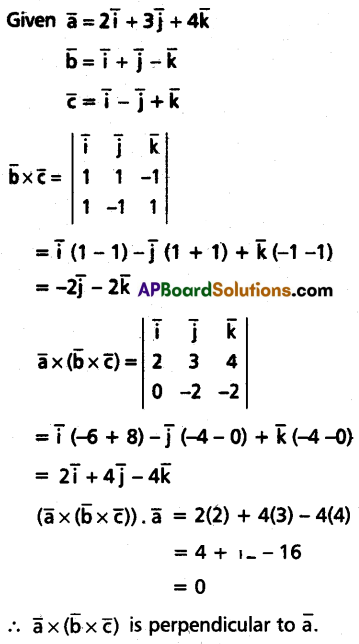
Question 14.
Prove that \(\cot \frac{\pi}{16} \cdot \cot \frac{2 \pi}{16} \cdot \cot \frac{3 \pi}{16} \ldots \ldots \ldots \cot \frac{7 \pi}{16}\) = 1.
Solution:
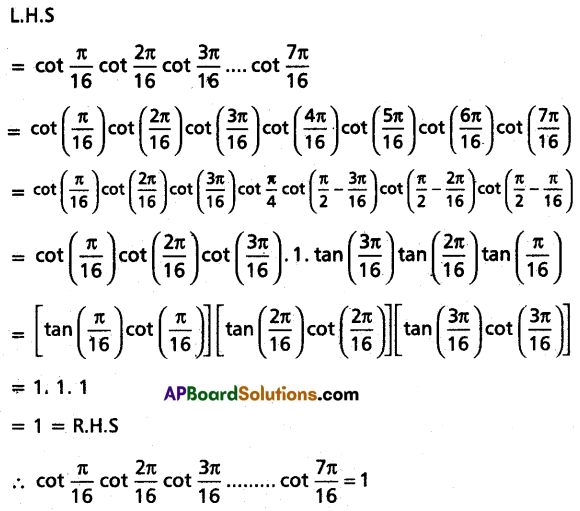
Question 15.
Solve √3 sin θ – cos θ = √2.
Solution:
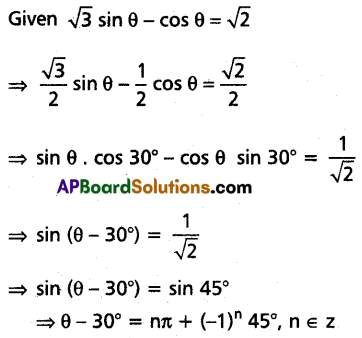

Question 16.
If tan-1 x + tan-1 y + tan-1 z = π, then show that x + y + z = xyz.
Solution:
Let tan-1 x = A ⇒ x = tan A
tan-1 y = B ⇒ y = tan B
tan-1 z = C ⇒ z = tan C
Given tan-1 x + tan-1 y + tan-1 z = π
⇒ A + B + C = 180°
⇒ A + B = 180° – C
⇒ tan (A + B) = tan (180° – C)
⇒ \(\frac{\tan A+\tan B}{1-\tan A \tan B}\) = -tan C
⇒ \(\frac{x+y}{1-x y}\) = -z
⇒ x + y = -z + xyz
⇒ x + y + z = xyz
![]()
Question 17.
In a ΔABC, show that \(\frac{\cos A}{a}+\frac{\cos B}{b}+\frac{\cos C}{c}=\frac{a^2+b^2+c^2}{2 a b c}\).
Solution:

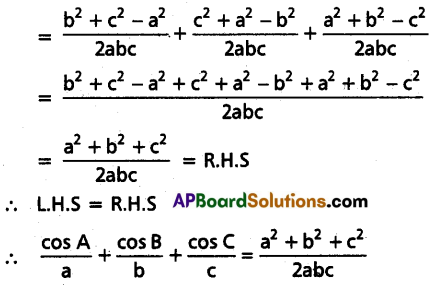
Section – C
(5 × 7 = 35 Marks)
III. Long Answer Type Questions.
- Attempt any five questions.
- Each question carries Seven marks.
Question 18.
If f: A → B, g: B → C are bijective functions, then show that gof: A → C is a bijection.
Solution:
∵ f: A → B, g: B → C by composite function gof: A → C
∵ f: A → B, g: B → C are bijections
Let a1, a2 ∈ A be such that (gof) (a1) = (gof) (a2)
⇒ g(f(a1)) = g(f(a2))
⇒ f(a1) = f(a2); {∵ g is an injection (bijection)}
⇒ a1 = a2; {∵ f is an injection (bijection)}
∴ gof: A → C is an injection
Let c ∈ C, since g: B → C is surjection, (bijection)
there exists b ∈ B such that g(b) = c.
Since f: A → B is surjection, (bijection)
there exists a ∈ A; such that f(a) = b
∴ C = g(b)
= g(f(a))
= (gof) (a)
∴ For each c ∈ C, there exists “a” ∈ A such that (gof) (a) = c
Hence gof: A → C is a surjection
Therefore gof: A → C is bijection.
Question 19.
Show that ∀ n ∈ N, \(\frac{1}{1.4}+\frac{1}{4.7}+\frac{1}{7.10}\) + ……… upto n terms = \(\frac{n}{3 n+1}\) by mathematical induction.
Solution:
In denominator
1, 4, 7,……. are in A.P
nth term = 1 + (n – 1)3
= 1 + 3n – 3
= 3n – 2
4, 7, 10,……. are in A.P
nth term = 4 + (n – 1)3
= 4 + 3n – 3
= 3n + 1
nth term of the series is \(\frac{1}{(3 x-2)(3 x+1)}\)
Let P(n) be the statement that
\(\frac{1}{1.4}+\frac{1}{4.7}+\frac{1}{7.10}+\ldots \ldots .+\frac{1}{(3 n-2)(3 n+1)}=\frac{n}{3 n+1}\)
If n = 1 then
L.H.S = \(\frac{1}{1.4}=\frac{1}{4}\)
R.H.S = \(\frac{1}{3(1)+1}=\frac{1}{4}\)
∴ L.H.S = R.H.S
∴ P(1) is true.
Assume that P(K) is true.
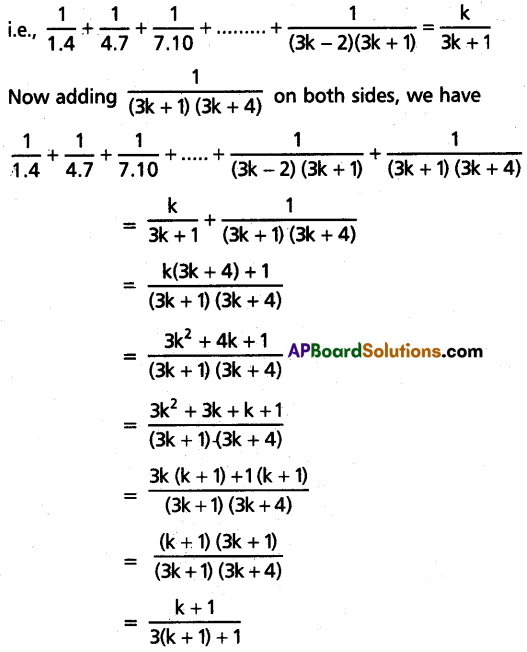
∴ P(k + 1) is true.
By the principle of finite mathematical induction P(n) in for all position integral values of n.
Question 20.
Show that \(\left|\begin{array}{ccc}
a & b & c \\
a^2 & b^2 & c^2 \\
a^3 & b^3 & c^3
\end{array}\right|\) = abc (a – b) (b – c) (-a).
Solution:
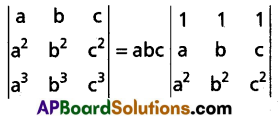
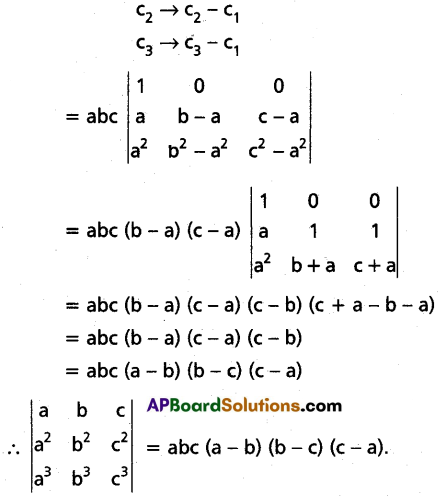
Question 21.
Solve the system of equations x + y + z = 3, 2x + 2y – z = 3, x + y – z = 1 by the Gauss-Jordan method.
Solution:
Given system of equations are
x + y + z = 3
2x + 2y – z = 3
x + y – z = 1
The given system of equations can be written as AX = D
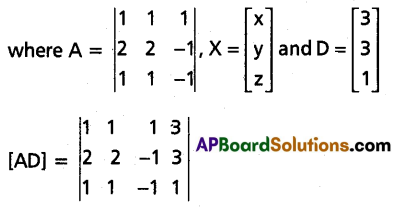
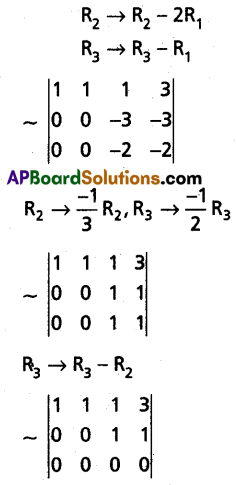
Here Rank (A) = 2, Rank ([AD]) = 2 and n = 3
∴ Rank (A) = Rank ([AD]) < n
∴ The given system is consistent and it has infinitely many solutions.
∴ x + y + z = 3
z = 1
If x = k then y = 2 – k
∴ x = k, y = 2 – k, z = 1, k ∈ R.
![]()
Question 22.
Find the shortest distance between the skew lines \(\bar{r}=(6 \bar{i}+2 \bar{j}+2 \bar{k})+t(\bar{i}-2 \bar{j}+2 \bar{k})\) and \(\bar{r}=(-4 \bar{i}-\bar{k})+s(3 \bar{i}-2 \bar{j}-2 \bar{k})\).
Solution:
Let \(\overline{\mathrm{a}}=6 \overline{\mathrm{i}}+2 \overline{\mathrm{j}}+2 \overline{\mathrm{k}}\)
\(\overline{\mathrm{b}}=\overline{\mathrm{i}}-2 \overline{\mathrm{j}}+2 \overline{\mathrm{k}}\)
\(\bar{c}=-4 \bar{i}-\bar{k}\)
\(\overline{\mathrm{d}}=3 \overline{\mathrm{i}}-2 \overline{\mathrm{j}}-2 \overline{\mathrm{k}}\)
The equation of the line through \(\bar{a}\) and parallel to \(\bar{b}\) is
\(\overline{\mathrm{r}}=\overline{\mathrm{a}}+\mathrm{t} \overline{\mathrm{b}}\) ……(1)
The equation of the line through \(\bar{c}\) and parallel to \(\bar{d}\) is
\(\overline{\mathrm{r}}=\overline{\mathrm{c}}+s \overline{\mathrm{d}}\) ……(2)
The shortest distance between the Skew lines (1) and (2) is \(\frac{|[\overline{\mathbf{a}}-\overline{\mathbf{c}} \overline{\mathrm{b}} \overline{\mathrm{d}}]|}{|\overline{\mathrm{b}} \times \overline{\mathrm{d}}|}\)
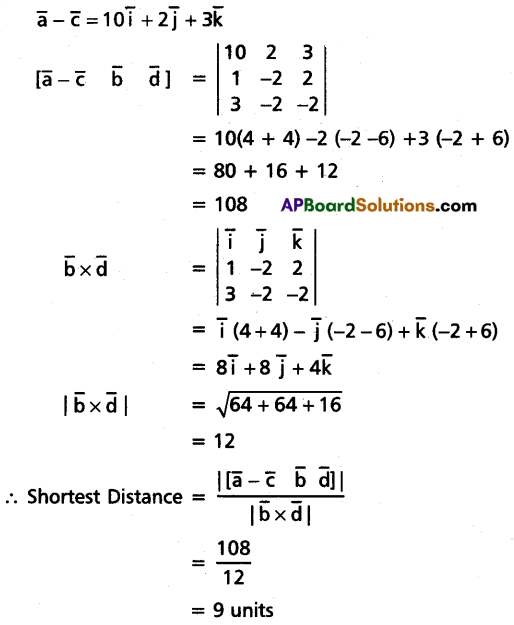
Question 23.
If A + B + C = π, then prove that \(\cos ^2 \frac{A}{2}+\cos ^2 \frac{B}{2}+\cos ^2 \frac{C}{2}=2\left(1+\sin \frac{A}{2} \cdot \sin \frac{B}{2} \cdot \sin \frac{C}{2}\right)\).
Solution:
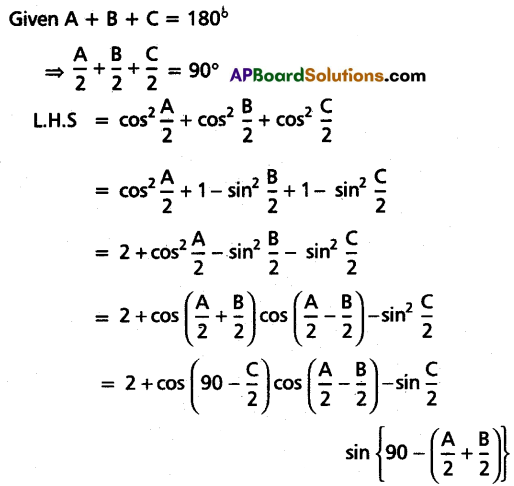
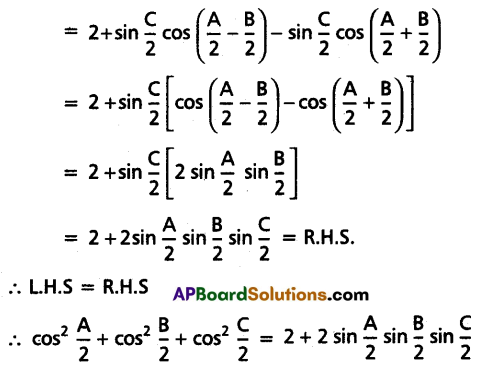
![]()
Question 24.
In a ΔABC, if a = 13, b = 14, c = 15 then show that R = \(\frac{65}{8}\), r = 4, r1 = \(\frac{21}{2}\), r2 = 12 and r3 = 14.
Solution:

